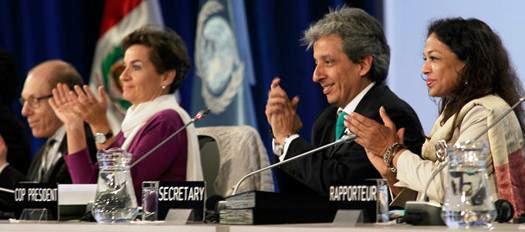Lima, Peru – A new 2015 agreement on climate change, that will harness action by all nations, took a further important step forward in Lima following two weeks of negotiations by over 190 countries.
Nations concluded by elaborating the elements of the new agreement, scheduled to be agreed in Paris in late 2015, while also agreeing the ground rules on how all countries can submit contributions to the new agreement during the first quarter of next year.

These Intended Nationally Determined Contributions (INDCs) will form the foundation for climate action post 2020 when the new agreement is set to come into effect.
During the two week 20th Conference of the Parties (COP20), countries also made significant progress in elevating adaptation onto the same level as action to cut and curb emissions.
Manuel Pulgar-Vidal, the Minister of the Environment of Peru and the COP President, said: “Lima has given new urgency towards fast tracking adaptation and building resilience across the developing world – not least by strengthening the link to finance and the development of national adaptation plans.”
“Meanwhile here in Lima, governments have left with a far clearer vision of what the draft Paris agreement will look like as we head into 2015 and the next round of negotiations in Geneva,” he said.
The Lima Climate Conference achieved a range of other important outcomes and decisions and “firsts” in the history of the international climate process.
- Pledges were made by both developed and developing countries prior to and during the COP that took the capitalization of the new Green Climate Fund (GCF) past an initial $10 billion target.
- Levels of transparency and confidence-building reached new heights as several industrialized countries submitted themselves to questioning about their emissions targets under a new process called a Multilateral Assessment.
- The Lima Ministerial Declaration on Education and Awareness-raising calls on governments to put climate change into school curricula and climate awareness into national development plans.
Christiana Figueres, Executive Secretary of the United Nations Framework on Climate Change (UNFCCC), said: “Governments arrived in Lima on a wave of positive news and optimism resulting from the climate action announcements of the European Union, China and the United States to the scaling up of pledges for the Green Climate Fund.”
“They leave Lima on a fresh wave of positivity towards Paris with a range of key decisions agreed and action-agendas launched, including on how to better scale up and finance adaptation, alongside actions on forests and education,” she said.
Ms. Figueres also thanked Ollanta Humala, the President of Peru, along with the government and the people of Peru for hosting the United Nations and some 11,000 delegates from all over the world.
“The negotiations here reached a new level of realism and understanding about what needs to be done now, over the next 12 months and into the years and decades to come if climate change is to be truly and decisively addressed,” she said.
Ms. Figueres thanked the Peruvian Environment Minister and President of the Conference of the Parties for his leadership.
“The cooperation of over 190 countries in securing many positive outcomes owes much to the patience and persistence of the COP President-Manuel Pulgar-Vidal -and the spirit of Lima as we look forward to Paris – the city of lights and the city of love for our shared future and shared environment,” said Ms. Figueres.

















